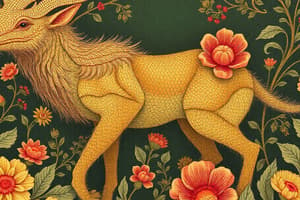Podcast
Questions and Answers
What is a key characteristic that differentiates animal cells from plant cells?
What is a key characteristic that differentiates animal cells from plant cells?
- Presence of chloroplasts
- Absence of cell walls (correct)
- Ability to photosynthesize
- Presence of cell walls
How do heterotrophic organisms obtain energy?
How do heterotrophic organisms obtain energy?
- By consuming other organisms (correct)
- By producing their own food through photosynthesis
- By absorbing nutrients directly from the soil
- By converting sunlight directly into energy
Which of the following best describes the primary difference between invertebrates and vertebrates?
Which of the following best describes the primary difference between invertebrates and vertebrates?
- Vertebrates possess a backbone or vertebral column, while invertebrates do not. (correct)
- Invertebrates are larger and more complex than vertebrates.
- Vertebrates are always terrestrial, while invertebrates are always aquatic.
- Invertebrates reproduce sexually, while vertebrates reproduce asexually.
What kind of symmetry does a starfish exhibit?
What kind of symmetry does a starfish exhibit?
What does the presence of body cavities in animals typically allow for?
What does the presence of body cavities in animals typically allow for?
Which term describes innate behaviors that do not require learning?
Which term describes innate behaviors that do not require learning?
Which of the following is NOT a function of animal physiology?
Which of the following is NOT a function of animal physiology?
What role does segmentation play in some animals?
What role does segmentation play in some animals?
Flashcards
What are animals?
What are animals?
Animals are multicellular, eukaryotic organisms that obtain energy by consuming other organisms.
Are animals motile?
Are animals motile?
Most animals can move independently. This is also known as being motile.
How do animals reproduce?
How do animals reproduce?
Animals typically reproduce sexually, but some can reproduce asexually.
What is a key feature of animal cells?
What is a key feature of animal cells?
Signup and view all the flashcards
How do animals obtain food?
How do animals obtain food?
Signup and view all the flashcards
What are the two major animal groups?
What are the two major animal groups?
Signup and view all the flashcards
What are animal adaptations?
What are animal adaptations?
Signup and view all the flashcards
What are the main types of symmetry in animals?
What are the main types of symmetry in animals?
Signup and view all the flashcards
Study Notes
Classification
- Animals are multicellular, eukaryotic organisms.
- They are heterotrophic, meaning they obtain energy by consuming other organisms.
- Most animals are motile, meaning they can move independently.
- They reproduce sexually, though some can reproduce asexually.
- Animals exhibit a wide range of structural complexity, from simple invertebrates to complex vertebrates.
Key Characteristics
- Cellular Structure: Animal cells lack cell walls.
- Heterotrophic Nutrition: They rely on external food sources.
- Movement: Most animals move actively during some stage of their life cycle.
- Multicellularity: Composed of multiple cells specialized for various functions.
- Sexual Reproduction: Typically involves the fusion of male and female gametes.
Types of Animals
- Invertebrates: Lack a backbone or vertebral column.
- Examples include insects, mollusks, crustaceans, worms, and jellyfish.
- Diverse group with varying body plans and adaptations.
- Vertebrates: Possess a backbone and an internal skeleton.
- Examples include mammals, birds, reptiles, amphibians, and fish.
- Larger animals with more complex organ systems.
Animal Body Plans
- Symmetry: Animals can exhibit radial or bilateral symmetry.
- Radial symmetry: Body parts arranged around a central axis (e.g., starfish).
- Bilateral symmetry: Body parts arranged on either side of a central plane (e.g., humans).
- Body Cavities: Some animals have a body cavity, which provides space for organs and allows for greater complexity.
- Segmentation: Some animals have segmented bodies, which allows for greater flexibility and movement.
Animal Diversity
- Numerous Phyla: Animals are classified into different phyla based on evolutionary relationships and shared characteristics.
- Adaptation: Animals have evolved diverse adaptations to suit various environments and lifestyles.
- Examples: Camouflage, mimicry, and specialized diets or feeding mechanisms.
Animal Behavior
- Instinctive Behavior: Innate behaviors that are fixed and do not require learning.
- Learned Behavior: Behaviors acquired through experience and adaptation.
- Social Organization: Many animals live in groups or societies, exhibiting cooperation and communication.
Animal Physiology
- Respiration: Animals have various respiratory systems (e.g., lungs, gills, skin) for gas exchange.
- Circulation: Systems for transporting nutrients and oxygen throughout the body.
- Excretion: Systems for removing waste products.
- Other systems: Nervous and endocrine systems coordinate responses to the environment.
Ecology
- Food Webs: Animals play crucial roles in food webs, interacting with other organisms and their environment.
- Predators and Prey: Animals are often predators or prey, influencing the populations of other species.
- Habitats: Animals occupy diverse habitats, from aquatic environments to terrestrial ones.
Studying That Suits You
Use AI to generate personalized quizzes and flashcards to suit your learning preferences.




